Celebrating a new year and the third month profiling my tree, Retama, Parkinsonia aculeata, I thank Lucy at Loose and Leafy for hosting Tree Following. I’m a day late because I host my own little meme, Wildlife Wednesday on the first Wednesday of each month, but I certainly don’t want to miss reporting about my tree or viewing what others have written about theirs.
There are no major changes with the Retama since December.
The Retama has fewer leaf stalks and virtually none of the tiny opposite leaflets remain, so it’s mostly about the green stems and bark.
Stems and bark remain green, year round, so the tree is especially nice in winter as it always has cheery, fresh color.
The one exception is this branch, 
…which has died. I was going to prune it off, but I noticed that birds often perch on it. The branch is not in my way and is not bothersome in any other fashion, so I’ll leave it. Who am I to remove a perfectly good bird sitting area?
Birds like this tree. A lot.
It’s rare that I look at the Retama and isn’t some bird, somewhere, in the tree.
House Sparrows,
Inca Doves,
…love it too.
And though it’s not an avian sort,
…this squirrel hugged the Retama early yesterday morning as a cold front dropped temperatures to the coldest of the season so far.
The remaining leaf stalks are green and continue to give the tree a feathery look against the various winter skies.
I notice the thorns along the branches more this time of year–better to avoid them as I dump mulched leaves around the base of the tree and in the garden in which it resides.
It’s consistently chilly now, downright cold at times, so I imagine the low temperatures will take care of relieving the Retama of its remaining foliage. The green branches and trunk will endure though, preparing the tree for its long growing season ahead.
Please enjoy other trees from all over as they’re followed this January by visiting Loose and Leafy and its celebration of all things trees.


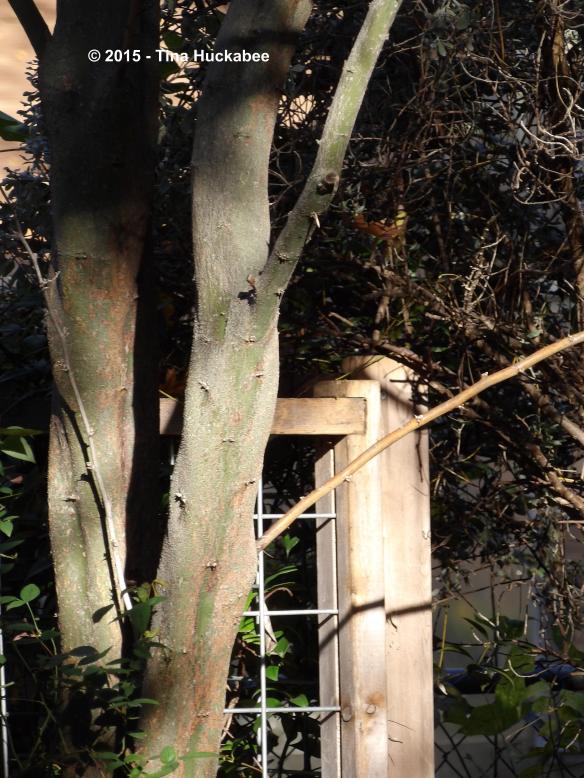
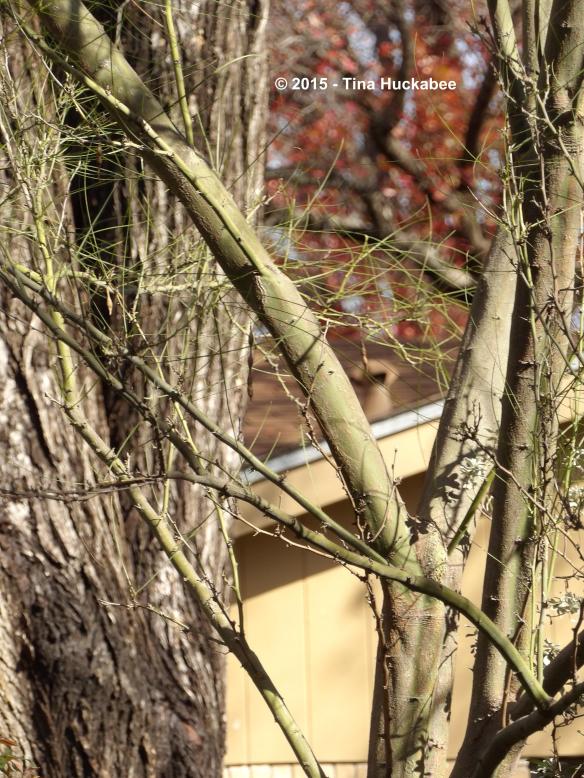
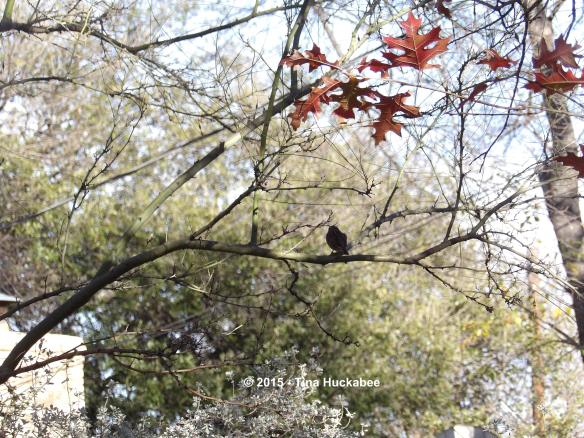

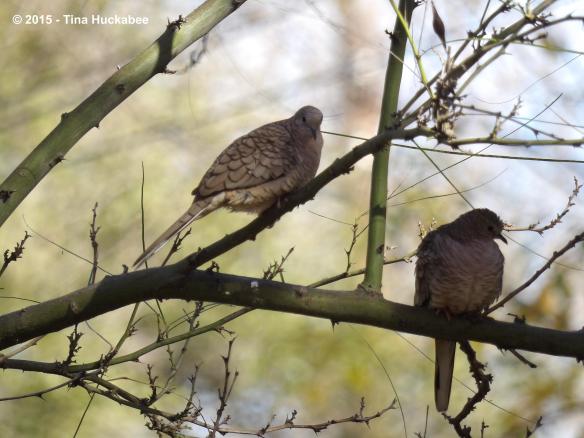
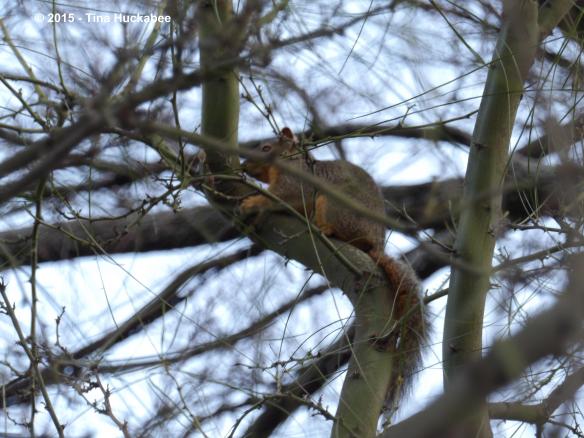
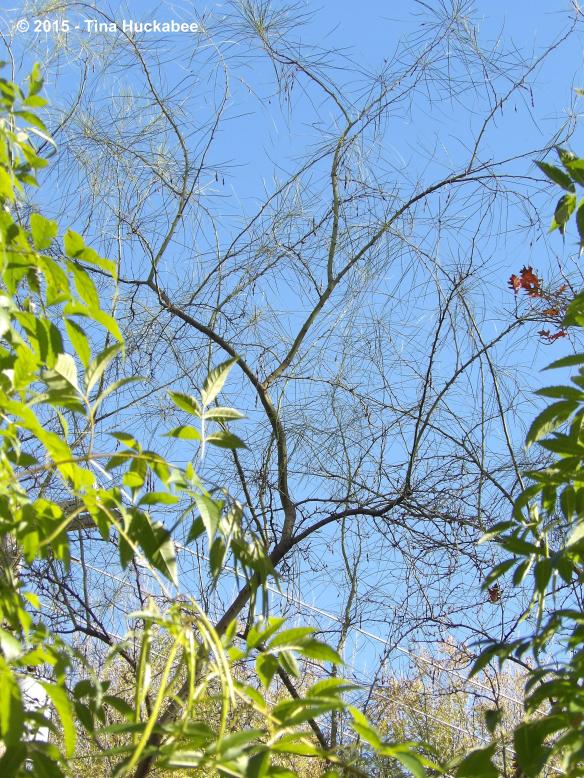
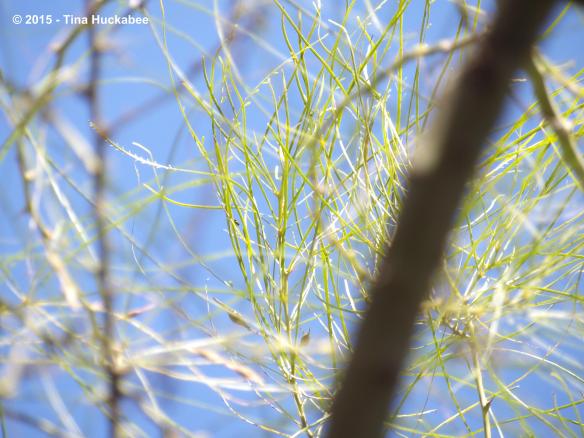


Ooof. I’m betting last night’s lows will take care of those remaining leaves in a big hurry. What is it with squirrels and tree hugging? We have several that routinely hug a large oak during warmer months and we assumed it was for the cooler temperatures close to the trunk. But during cold weather? Perhaps the trunks provide a constant temperature in mini-micro-climate fashion? Like a cave in reverse?
You are truly a wildlife gardener as proven by your willingness to leave a dead limb as a bird perch. I might try to do that but I bet inside a week I’d be out with the hand saw. My family doesn’t even ask anymore when they see I’ve been out pruning because I always have the same answer “it offendeth mine eye!”.
LikeLike
It’s very cold this morning. I covered a few things (I love dianella and it’s a bit tender, so it’s the plant that I always cover.), but I’m glad to finally have a hard freeze. I’ve seen squirrels spread out on my oak limbs in the summer–cooling off I presume, but that little dude yesterday, cuddled up on the branch, charmed me so.
It’s funny that I have no pic of birds on the dead limb–everytime I see a bird perched, I grab my camera, but the darn things fly and I haven’t snapped a photo yet. I promise–birds like that limb.
If the branch was a problem, I’d probably trim it, but otherwise, I tend to let well-enough alone–but I certainly understand offense by wayward plants, limbs and the like!
LikeLike
What a nice-looking tree. Good for you regarding the dead branch. I usually shorten them a little and leave them at least for a little while. They seem to make good holders for bird feeders, rather than the living ones that bend too much. I guess whatever is still going to die back around here will finally do it — when I looked at the thermometer around 8 AM it was 17 degrees. Our squirrel wasn’t hugging a tree, he was sitting on the bird bath licking the ice!
LikeLike
Awe, poor little squirrel. I ran out early this morning and dumped several tea kettles full of hot water on my bird baths, but they’re still freezing up. We’re not quite as cold (mid-20s), but cold enough.
LikeLike
I really like the green of the trunk. And I love that first picture. Something about it feels really harmonious — like the shapes and colours of the tree, fence and shrubs keep the house in its place. Hope you can stay warm and safe today =)
LikeLike
I like that shot too. When the sun is setting and in just the right spot, it sort of highlights the green of the tree. I haven’t yet been successful at capturing that green “glow”–but it’s quite striking.
You stay warm too. Though I’m sure this cold-weather is chump change for you. 🙂
LikeLike
nah Cold is cold. One of Austin’s draws for me was the hot hot summer believe it or not.
LikeLiked by 1 person
I like our long hot summers too. I’m contemplating (just researching at this point) a move to the Pacific Northwest–Oregon. I adore their summers, but honestly, I don’t know if I can take months of chilly weather. And dark days. That”s what has me concerned–I”m a sunshine girl, to be sure.
LikeLiked by 1 person
I love the fact that your tree stays green in branch and bark. It reminds me a bit of the state tree in AZ.
LikeLike
They’re related trees–the Arizona tree is Parkinsonia florida!!
LikeLike
I’m not familiar with the Retama tree. It has a fascinating form! I’m taking a break from the tree-following this year, which will give me more time to follow trees on other blogs like yours!
LikeLike
It’s a beautiful tree, Beth. It has so many good qualities. I grew up seeing Retamas along roads and highways–it’s so tough and requires nothing.
Sorry you’re not tree following, but I can understand taking a break. I hope you’ll continue to blog–I love to read your wonderful posts.
LikeLike
What beautiful photos – and those doves!
http://carolinegillwildlife.blogspot.co.uk/2015/01/tree-following-silver-birch-in-december.html
LikeLike
Thanks, Caroline! The Incas are cute, aren’t they?
LikeLike
I love learning about trees which are unfamiliar to me. Yours is a beauty. It’ s great how you capture the pictures of the creatures who live in it.
I didn’ t know that Dianella isn’ t hardy, thanks for the information. I’ d better check that mine is alright, I would hate to lose it, it was new last year.
LikeLike
That’s the great thing about this tree following thing, isn’t it? Exposure to trees that we no nothing about–I’ve really enjoyed reading about other trees. I just love my Retama–I’m so glad that I planted it. Buying it was one of those whimsical, spur-of-the-moments purchases that I usually regret, but I’ve never regretted this tree.
My experience with the Dianella is that it’s ok in a light freeze that is of short duration, but for extended periods of time, in the 20s, I cover it. If it suffers some freeze damage, just prune off the damaged straps in the spring–mine have mostly returned with full vigor.
LikeLike
Thanks for the Dianella advice Tina.
LikeLike
You’re most welcome, Chloris. Many gardeners in Austin complain about the Dianella not being winter hardy, but I’ve found with just a little covering-care, they come through our winters just fine. As a disclosure, I live in the central Austin, so I have some benefit(?) of a heat island effect. It gets colder in the outlying areas and it might be harder to save Dianella in the case of temperatures in the teens.
LikeLike
You have been nominated for the Leibster blog Award; a warning that there is absolutely no chocolate or trophy to be received: http://botanicallyinclined.org/a-casual-award-ceremony/
LikeLike
Goodness. I’m flattered, very flattered, but shy about accolades. And coming up with questions. And really, no chocolate? Not even a bling-thing to put on the side bar of the blog? I’ll have to think about questions and moving forward with this. Regardless, thank you, thank you, thank you!! So tickled at the compliment!
LikeLike
I think there is ‘bling-thing’ that you can wear afterwards 😉 It is always good to explore more blogs, if only more time in the day to follow them all!
LikeLike
Even bare branches are beautiful, especially adorned with softly feathered birds. I have no idea what the Retama looks like while in leaf (I only just joined Lucy’s tree-following) but I love its twisty trunk; it looks almost muscled in a way. It has become apparent to me, while working my way through her Linkey List, that a lot will be learned by me about trees in all their varied glory. I am looking foward to it.
LikeLike
Hi Sara! Thanks for dropping by and I’m sure you’ll enjoy the tree following–both in your own participation and in reading other posts.
The Retama is a smoothly muscular tree–I’d never thought of it that way, but I suppose its limbs are like a runner’s or swimmer’s leg-strong, lean, but powerful. It’s a beautiful tree–I’m glad I chose it and I’ve already learned so much about the Retama.
LikeLike
The green-ness and the smooth-ness . . . there’s something disconcerting about them. There seems to be an unusually sharp contrast, with this tree, between its summer and winter ‘atmosphere’.
LikeLike
It is a very green tree, I have to admit. That’s especially interesting because it’s a tree that, in its natural area, receives very little regular rain. Just one of the many reasons I love it!
LikeLike
I am not familiar with Retama trees at all, this is my first month tree following and I am going to learn so much! I love the arrangement of the leaf stems and the colour of the stems and branches.
LikeLike
Hi! And thanks for stopping in! You will learn a lot with this tree following business. I love the Retama. It’s a native to the Southwest US tree, so unless you’re from that area…you’re probably not familiar. But it’s a wonderful tree and I’m enjoying learning more as I follow it.
LikeLike
I really look forward to learn more about Retama – it’s a new one to me!
LikeLike
It’s a great little tree. As I’m reading about it, I’ve learned so much that I had no idea of, so I’m looking forward to learning more too!
LikeLike
Pingback: A Seasonal Look: Retama (Parkinsonia aculeata) | My Gardener Says…